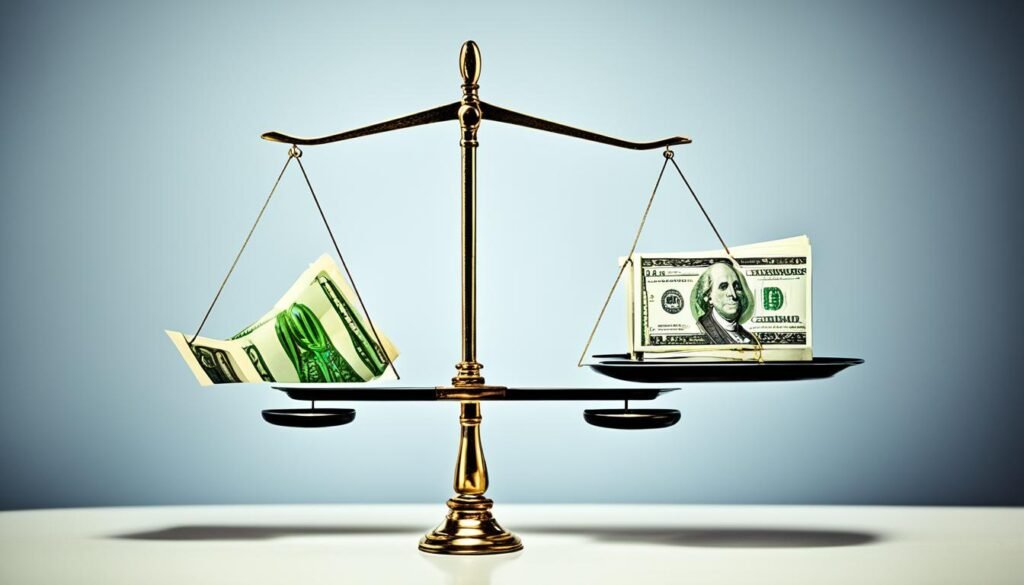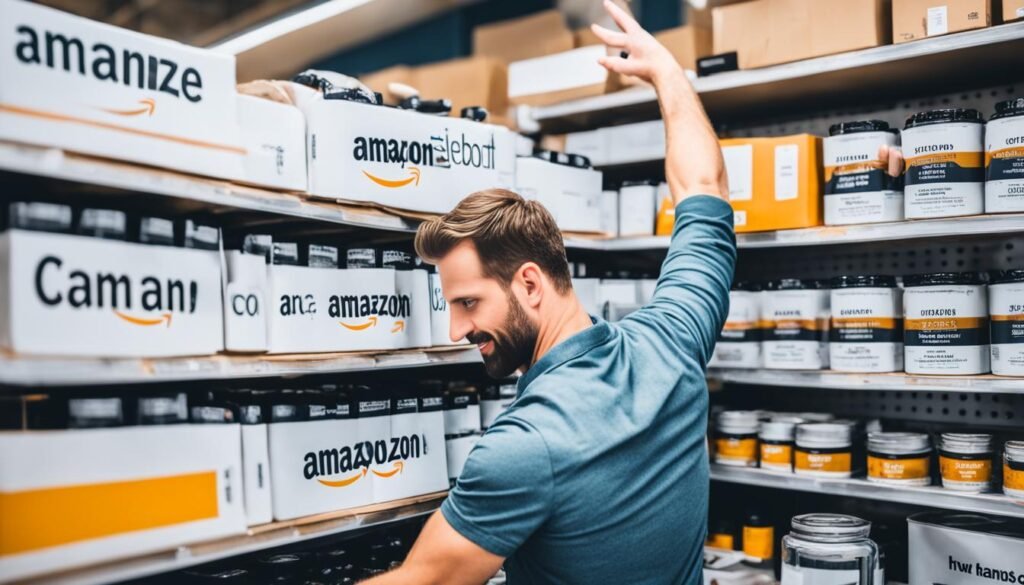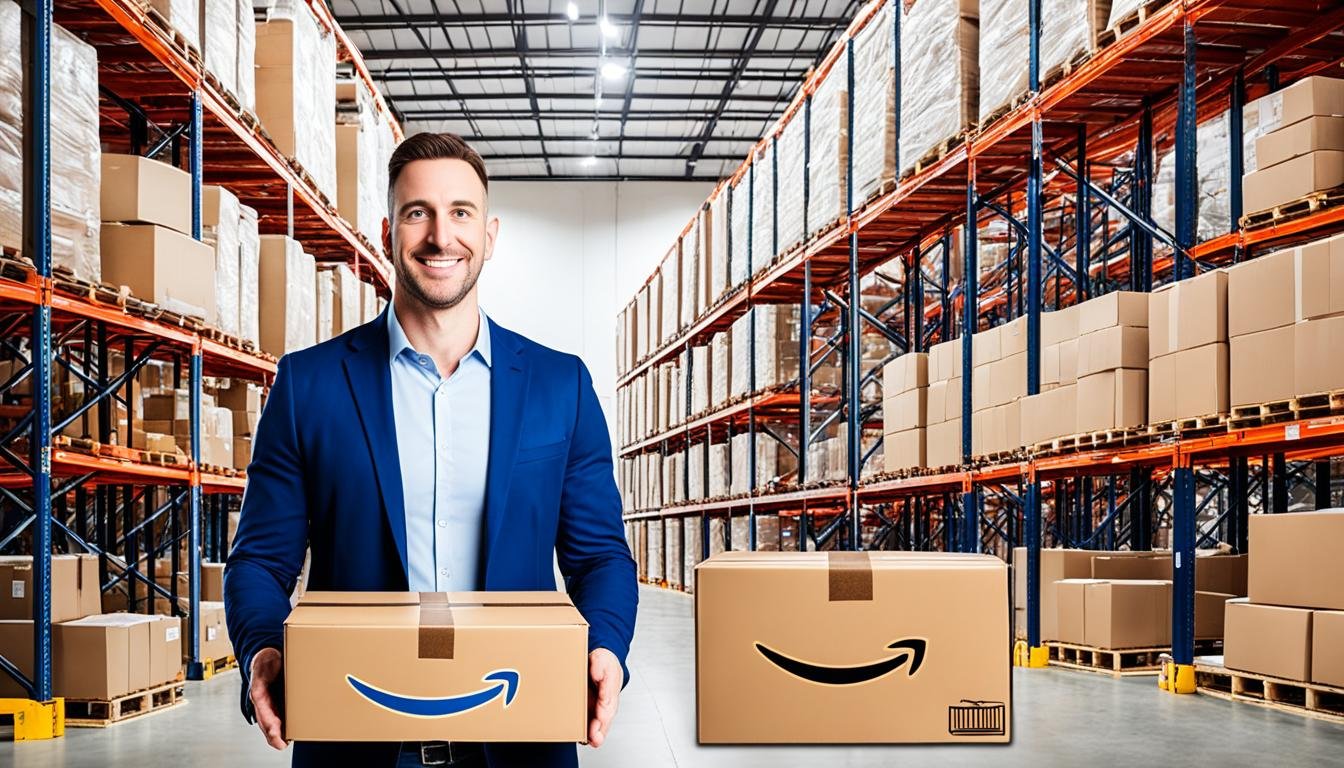Choosing between Amazon Fulfillment by Amazon (FBA) and dropshipping is key for your online business. Each model has its benefits. But which one fits your goals and resources better?
Here, we’ll look closely at Amazon FBA and dropshipping’s details. We’ll show you their pros, cons, and why one may be better for you. By the end, you’ll know which option is right for your online business dreams1.
Key Takeaways
- Amazon FBA is preferred by 89% of sellers due to its convenient order fulfillment process1.
- Dropshipping is a popular low-cost model, attracting 57% of new e-commerce entrepreneurs1.
- Amazon FBA provides the Prime shipping badge, boosting customer trust, while dropshipping can lead to slower delivery times1.
- Startup costs for Amazon FBA are higher, but it can lead to profitability within 3-6 months2.
- Dropshipping offers more control over the business process compared to Amazon FBA2.
Understanding Amazon FBA
Fulfillment by Amazon (FBA) is a service changing how sellers work online. Amazon takes care of storage, order processing, and customer service. This is great for big or small businesses3.
What is Fulfillment by Amazon (FBA)?
It’s a service where sellers keep their products in Amazon’s locations. When someone buys, Amazon manages everything. This includes picking, packing, shipping, and dealing with returns3.
This system is perfect for sellers using their own brands or those selling in bulk. It makes work easier for them on Amazon3.
Benefits of Using Amazon FBA
Amazon FBA offers many pluses:
- It’s an efficient way to sell, which customers like3
- Sellers can reach Amazon’s huge customer base3
- Products can have Amazon Prime shipping, boosting sales3
- It takes care of customer service and returns, saving sellers time3
Yet, there are also downsides. These include fees, storage costs, and limits on what you can restock. Plus, there’s always a tiny chance of losing some items3.
“Amazon FBA changes the game for online sellers, giving them a way to grow without the usual hassle of managing orders.”
In the end, Amazon FBA is a full service that can really help sellers get bigger. It’s great for making customers happy too345.
Understanding Dropshipping
In e-commerce, dropshipping is now top choice for those wanting to sell online. It’s a method where sellers don’t keep inventory. Instead, they forward orders to suppliers who then ship the products directly to customers6.
What is Dropshipping?
The dropshipping business model is loved for its ease and flexibility. It lets you start selling online with little money down. You don’t need to buy or store any products. You just connect buyers with suppliers and earn a cut from each sale6.
Advantages of Dropshipping
There are several perks to dropshipping that make it appealing to many:
- Low startup costs: No need for big investments in buying and storing products6.
- Flexibility: It’s easy to change your products online since you don’t physically handle them6.
- Reduced overhead: You won’t worry about shipping, so you can focus on other parts of your business6.
- Expanded product offerings: There’s no limit to what you can sell since you don’t have to keep them in stock6.
- Customizable branding: You can make your product pages and brand stand out on websites like Amazon6.
Yet, there are downsides too. These include more competition, the risk of quality problems, and longer shipping times for buyers6.
“Dropshipping is a game-changer for aspiring ecommerce entrepreneurs looking to start an online business with limited resources. It offers a low-risk, flexible path to online selling that can be customized to fit your unique brand and goals.”
amazon fba vs dropshipping
Amazon FBA and dropshipping are popular in e-commerce. They offer unique pros and cons. This makes it vital for those starting in online retail to know the differences7.
Amazon FBA means sellers send their items to Amazon’s centers. Amazon then takes care of storing, packing, and delivering these products for the seller7. In dropshipping, a third party sends products directly to customers. Sellers don’t handle the products themselves8.
Ordering is also different. FBA sellers get Amazon’s fast delivery and excellent customer service. Dropshippers depend on their supplier for shipping, leading to longer waits71.
The two models require different amounts of money to start. FBA comes with various fees like Fulfillment and Storage Fees7. Dropshipping is often seen as cheaper and less risky, good for starters8.
For growth, Amazon FBA has a big advantage because of Amazon Prime and trust from customers71. Dropshipping struggles with lots of competition and less control over product quality1.
Choosing between Amazon FBA and dropshipping depends on your goals and what you’re willing to risk. Thinking these through will help e-commerce starters decide what’s best for their business718.
Key Differences Between FBA and Dropshipping
Amazon FBA and dropshipping are unique ecommerce models with their own set of benefits and difficulties. It’s important for entrepreneurs in online retail to grasp these differences. This understanding is vital in the fast-changing ecommerce landscape.
Inventory Ownership
One major difference is who owns the products. Amazon FBA sellers keep their products and send them to Amazon’s centers6. In dropshipping, sellers don’t physically have the items. The supplier ships orders directly to customers.
Order Fulfillment Process
The way orders are handled is where these models contrast the most. With Amazon FBA, Amazon deals with everything from packing to shipping to customers6. Dropshipping sellers rely on their suppliers to fulfill orders, potentially leading to slower delivery times and issues with customer service3.
These differences affect the business in significant ways. They impact costs, how much control you have, and how easily you can grow your business.
“Understanding the key differences between Amazon FBA and dropshipping is crucial for ecommerce entrepreneurs looking to navigate the ever-evolving world of online retail.”
Startup Costs and Investment
Starting an ecommerce business differs in costs between Amazon FBA and dropshipping9. Amazon FBA gets money for monthly subscriptions, referring items, storing inventory, and handling orders. Due to these charges, profit margins can shrink9. But, dropshipping needs little money upfront, which is good for those starting with less9.
Amazon FBA sellers buy products first and then send them to Amazon. This can cost a lot at first, especially for expensive products910. Such a big upfront cost might stop some from starting since that money could be used for other business needs910.
On the flip side, dropshipping is cheaper to start911. Sellers list products online and buy them from suppliers only after customers buy them. This means no need to pay for products in advance911. It’s a great choice for those wanting to start an online store with limited cash911.
Yet, dropshipping comes with its own set of issues. It can be hard to control product quality without managing the stock911. This might affect the trust in your suppliers and your money-making potential911.
Deciding between Amazon FBA and dropshipping depends on what someone wants and what they have to spend10. Some mix both, selling fast-moving items through Amazon FBA and adding more items with dropshipping. This strategy can be a savvy way to blend the benefits of both options10.
Profitability and Scalability
Amazon FBA and dropshipping vary in their profitability and scalability. With dropshipping, turning a profit on your first sale is common4. But Amazon FBA can lead to higher profits per sale. This is because FBA products are Amazon Prime eligible, bringing in more customers.
Additionally, Amazon FBA’s efficient fulfillment processes reduce sellers’ logistical work12.
Time to Profit
Starting to make money differs between the two methods. Amazon FBA sellers might wait 3-6 months to see steady profits, after covering their inventory cost12. Conversely, dropshippers can make money right away without investing in stock upfront4.
However, dropshipping faces hurdles. It can be harder to achieve higher profits because of strong competition and fluctuating supplier prices4.
| Metric | Amazon FBA | Dropshipping |
|---|---|---|
| Upfront Investment | Higher due to inventory management | Lower, only purchasing products after sales |
| Profit Margins | Higher due to Prime eligibility and faster shipping | Lower due to competition and supplier pricing |
| Time to Profit | Typically 3-6 months to recoup inventory investment | Can generate profits from first sale |
| Scalability | Leverages Amazon’s infrastructure and customer base | Reliant on supplier capabilities and market conditions |
Looking at scalability, Amazon FBA has a clear advantage124. It allows sellers to tap into Amazon’s vast reach and efficient network for faster business growth. In comparison, dropshipping faces limitations in growing big, since it depends on the capabilities of its suppliers.

“Both Amazon FBA and dropshipping offer unique benefits and challenges when it comes to profitability and scalability. Entrepreneurs should carefully evaluate their business goals, resources, and preferences to determine the most suitable model for their needs.”
Control Over the Business
When talking about running an online store, how much control you have is key. Amazon FBA and dropshipping differ a lot in this area. Each method has its pros and cons for those selling online14.
Using Amazon FBA gives sellers less control. They must follow Amazon’s rules closely. This means their business can be hurt by Amazon’s changes or if they get suspended15. On the other hand, dropshipping lets sellers do more on their own. They can pick their own suppliers and do their own marketing. They aren’t tied to just one big platform15.
In dropshipping, having more control means more work. But it also means being able to do things your own way. Sellers can try new products or set their prices as they see fit. They don’t rely as much on a platform like Amazon15.
How much control you want is a big deal for those who choose Amazon FBA or dropshipping. It really depends on what the seller wants to achieve, how much risk they’re okay with, and their level of commitment. Some may prefer one method over the other based on these factors10.
“The choice between Amazon FBA and Dropshipping is crucial in determining the level of control you’ll have over your ecommerce business.”
It’s important for sellers to really think about these differences. Understanding them can lead to making the right choice for their business. This is key for success in the changing world of online selling platforms10.
Competition and Market Saturation
In the evolving world of ecommerce, Amazon FBA and dropshipping face their unique hurdles16. FBA needs more money to start than dropshipping. An Amazon seller account costs $39.99 per month16. Amazon’s site, with 2.45 billion monthly visits as of June 2021, stays on top16. This many visitors help Amazon FBA sellers. But, they have to fight similar product sellers and Amazon’s own brands.
Dropshipping, on the flip side, has lots of competition thanks to its simple, low-cost business model17. It lets you sell any product without storing it first. But, this lead to a crowded market, especially for popular items. Now, stores like Temu and Shein are joining in, making it even tougher18. To stand out, dropshippers might have to buy some stock. This makes shipping faster and builds their brand. Yet, they start with very little money up front.
Success in the online market means being smart and knowing the business well, no matter what you’re selling.17 Good money management keeps you profitable, and17 having the best tools for online sales is key. This goes for both FBA and dropshipping.

At the end of the day16, Amazon FBA sellers have the upper hand. They reach Amazon’s vast customer base. This gives them a big lead17. They can also ship fast thanks to Amazon’s Prime program. But, they face risks with their stock. Once it’s with Amazon, they might lose sales because of issues with the stock’s handling or misplacement17. Dropshipping lets you quickly adapt to new trends. However, dealing with returns and complaints without handling the products directly hits their customer service quality. This could make customers unhappy due to longer response times and issues not under their direct control17.
To do well in the tough world of Amazon FBA and dropshipping, you need a smart plan, deep market knowledge, and a drive to give great service17. Knowing what customers like and watching e-commerce trends are key to making it161718.
Conclusion
In the world of e-commerce, Amazon FBA and dropshipping stand out as good ways to do business. Each has its advantages and difficulties. Amazon FBA lets sellers enjoy Amazon’s large customer base and wide-reaching delivery network. Still, it costs more to start and you have less control over how your business runs19. Dropshipping, however, needs less money up front and offers more freedom. But, profits might be smaller and there’s a lot of competition out there1920.
Your pick between Amazon FBA and dropshipping should match your business goals, what resources you have, and how much risk you’re okay with. Those who want to leverage Amazon’s huge setup and well-known name might lean towards Amazon FBA. Yet, if funds are tight or you want to call the shots, dropshipping might interest you more1920.
No matter which way you go, doing your research and laying out a smart plan is key. Knowing the differences in things like owning inventory, how orders get sent out, and the costs and profits involved helps you make a choice that fits your business goals211920. And in the end, your careful thought and preparation pave the way for your e-commerce success.
FAQ
What is the difference between Amazon FBA and dropshipping?
What are the advantages of Amazon FBA?
What are the advantages of dropshipping?
How do the startup costs differ between Amazon FBA and dropshipping?
Which model is more profitable and scalable?
How much control does the seller have over their business in each model?
How do the competitive landscapes differ between Amazon FBA and dropshipping?
Source Links
- Amazon FBA vs. Dropshipping in 2024 – Which Is Better? – https://www.junglescout.com/resources/articles/amazon-fba-vs-dropshipping/
- Dropshipping vs FBA – Which is Better? (From Real Experience) – https://www.buildassetsonline.com/dropshipping-vs-fba/
- Amazon FBA vs. Dropshipping: The Pros And Cons – https://www.autods.com/blog/dropshipping-tips-strategies/fba-vs-dropshipping/
- Amazon FBA Vs Dropshipping: Evaluating The Pros And Cons – https://www.redswitches.com/blog/amazon-fba-vs-dropshipping/
- FBA vs. Dropshipping: Pros and Cons | Forum Brands – https://www.forumbrands.com/blog/FBA-vs-Dropshipping/
- Amazon FBA vs. Dropshipping: Which One Is Right For You? | Helium 10 – https://www.helium10.com/blog/amazon-fba-vs-dropshipping/
- Amazon FBA Vs Dropshipping: A Comparison [2024] – https://www.threecolts.com/blog-articles/amazon-fba-dropshipping
- Amazon FBA vs Dropshipping – Which Is Best For You? – https://www.dropship.io/blog/amazon-fba-vs-dropshipping
- Amazon FBA vs. Dropshipping | Gourmet Ads – https://www.gourmetads.com/articles/amazon-fba-vs-dropshipping/
- Amazon FBA vs Dropshipping: Pros and Cons in 2024 – North One – https://www.northone.com/blog/ecommerce/amazon-fba-vs-dropshipping
- Amazon FBA vs Dropshipping in 2024: Don’t Choose Wrong – https://www.linkedin.com/pulse/amazon-fba-vs-dropshipping-ahmed-moeez-gloaf
- Choosing Between Amazon FBA and Dropshipping: An In-Depth Analysis – CloudPages – https://www.cloudpages.cloud/blog/choosing-between-amazon-fba-and-dropshipping-an-in-depth-analysis/
- Is Amazon FBA Better Than Dropshipping? – OA Cheddar – https://oacheddar.com/is-amazon-fba-better-than-dropshipping/
- Dropshipping vs. Amazon FBA: Which Is Better? – https://redstagfulfillment.com/dropshipping-vs-amazon-fba/
- Which is the Best for Your Business?-Seller Sprite – https://www.sellersprite.com/en/blog/amazon-fba-vs-dropshipping
- Dropshipping vs. Amazon FBA: Which Is The Best Business Model? – https://www.mikevestil.com/wealth/dropshipping-vs-amazon-fba/
- Which is the Best for Your Business?-Seller Sprite – https://cn.sellersprite.com/en/blog/amazon-fba-vs-dropshipping
- Amazon FBA vs Dropshipping – https://www.3fin.io/post/amazon-fba-vs-dropshipping
- Amazon FBA vs Dropshipping: Which is Better in 2024 – https://sellersessions.com/amazon-fba-vs-dropshipping/
- Amazon FBA vs Dropshipping: Which Model Works Best for Sellers in 2024 | ZIK Analytics – https://www.zikanalytics.com/blog/dropshipping-vs-amazon-fba/
- Dropshipping vs Amazon FBA – All Pros & Cons Explained (2024) – https://sellermetrics.app/dropshipping-vs-amazon-fba-which-one-is-better/
